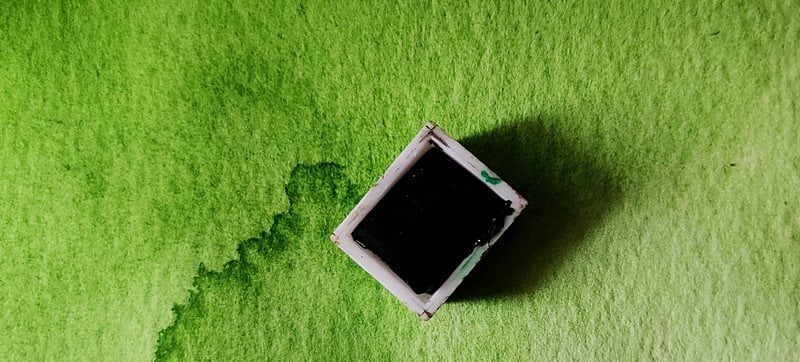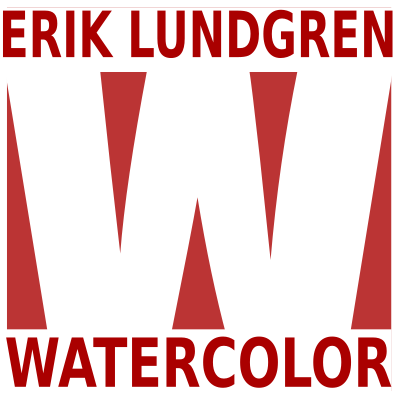Sap Green (NG2)

Sap green is another of all traditional colors that today is just an imitation. The original color Sap green was made from plant juices that were squeezed from, usually, unripe buckthorn berries, but also from other plants. The result was a yellow-green juice that you could paint with immediately, you can try it yourself, squeeze some green plant and try to paint with the juice you get. The problem with the paint is the durability, it will soon fade and disappear.
The original color can not be used because it fades very quickly, but there is a need for yellow-green color, and there is no suitable pigment with this color hue. Thus, manufacturers mix a yellow-green color, usually with Phthalo Green and some yellow. Some manufacturers add a red, black or brown color to make the green color a little more natural. But many use only Phthalo Green + Yellow.
Sap green must be the most unnecessary of all colors. It is ridiculously easy to mix yourself. Phthalo Green plus any yellow color. Add a little red color if you think the result is too unnatural green. Still, the paint is very popular and all paint manufacturers provide it. Some even have different variants of the color.

WINSOR & NEWTON – Permanent Sap green
Phthalo Green (YS) PG36
Isoindolinone yellow PY110

WINSOR & NEWTON : COTMAN – Sap green
Phthalo Green (YS) PG36
Isoindoline yellow PY139
Synthetic red iron oxide PR101

ROYAL TALENS : REMBRANDT – Sap green
Phthalo Green (BS) PG7
Nickel azomethine PY150

ST PETERSBURG : WHITE NIGHTS – Sap green
Phthalo Green (YS) PG36
Nickel azomethine PY150
Lampblack PBk7

MAIMERIBLU – Sap green
Chromium oxide PG17

M. GRAHAM – Sap green
Phthalo Green (BS) PG7
Isoindolinone yellow PY110

HOLBEIN – Sap green
Phthalo Green (BS) PG7
Nickel azomethine yellow PY150
Naphthol red PR122

DALER ROWNEY – Sap green
Phthalo Green (BS) PG7
Nickel dioxine yellow PY153
Synthetic red iron oxide PR101

DANIEL SMITH – Sap green
Phthalo Green (BS) PG7
Nickel azomethine yellow PY150
Quinacridone orange PO48

DANIEL SMITH – Sap green deep
Prussian blue PB27
Quinacridone orange PO48
Arylide yellow PY3

OLD HOLLAND : Sap green lake extra
Phthalo Green (BS) PG7
Benzimidazolone yellow PY151
Nickel dioxine yellow PY153
Synthetic yellow iron oxide PY42
Lampblack PBk7

SCHMINCKE – Sap green
Phthalo Green (BS) PG7
Nickel dioxine yellow PY153

BLOCKX – Sap green
Phthalo Green (BS) PG7
Benzimidazolone yellow PY154

SENNELIER – Sap green
French ultramarine PB29
Nickel dioxine yellow PY153












Is the image at the top of genuine sap green?
I thought PG10 or Daniel Smith’s Serpentine were better substitutes for genuine sap green. PG10 is no longer available as a paint.
I did not take the time to squeeze plants for the picture, it is W&N Sap green in the picture. PG10 or Green Gold is also one of my favorite colors, it disappeared almost 20 years ago. Nowadays, there are only bad imitations. Daniel Smith’s Serpentine Genuine is beautiful but expensive.
Thank you for replying. I almost forgot that I wrote this comment — silly me!
I do agree with you, PG10 is a beautiful pigment. Guerra Paints and Pigments in New York still have stock of the PG10 pigment, albeit a very limited one. I hope that one day I will be able to buy the pigment and make my own paint out of PG10.
So is Green Gold the same as PG10? Was that the name given to PG10? Today Green Gold is given to PY129, another pigment I would love to try. I love its earthy green-brown yellow hue, very good for landscapes and makes beautiful earth hues.
PS: the thought of you squeezing berries to make Sap Green is rather amusing, I must confess 🙂
PG10 is the original pigment that bore the name Green Gold, it probably got its name the metal (gold + silver). Production of PG10 ceased in the early 2000s and the paint manufacturers then decided to give the popular paints name to PY129.